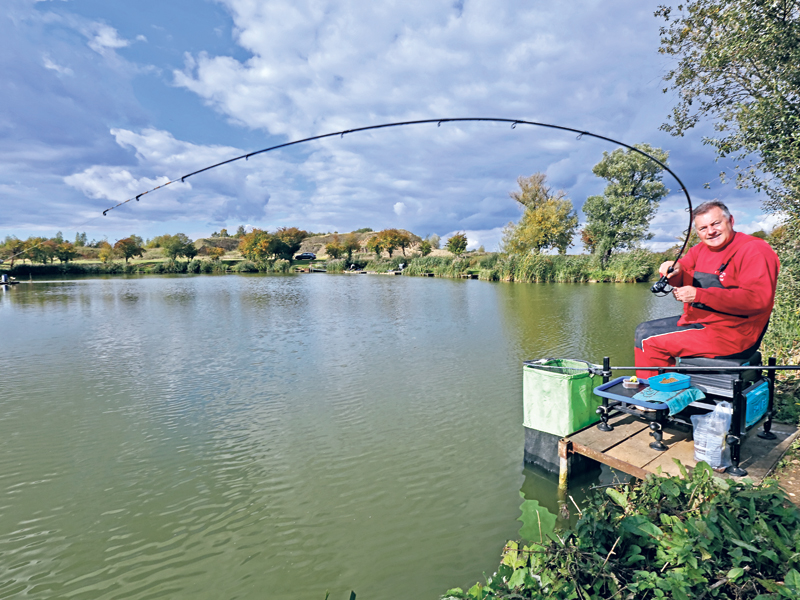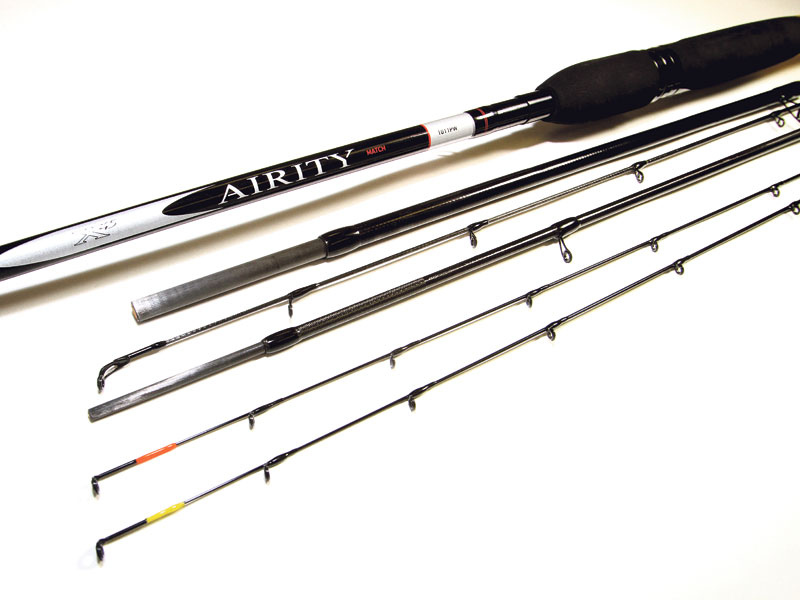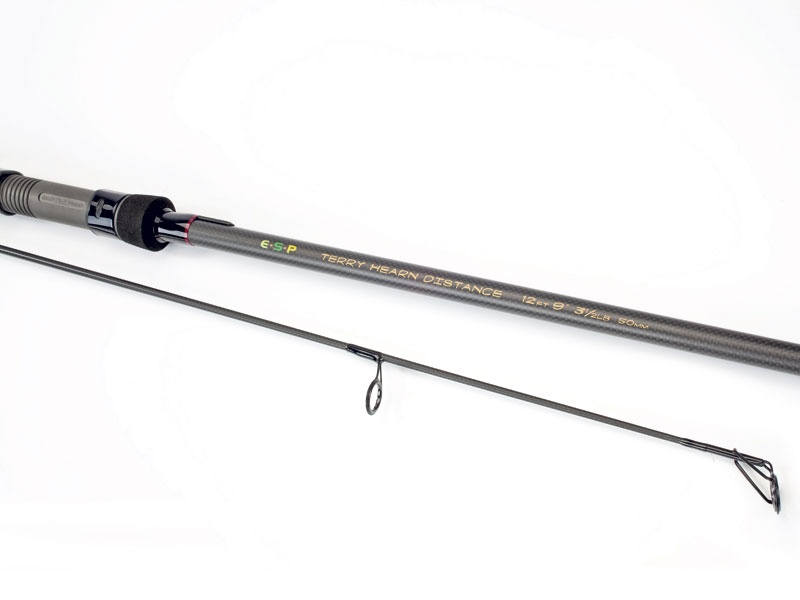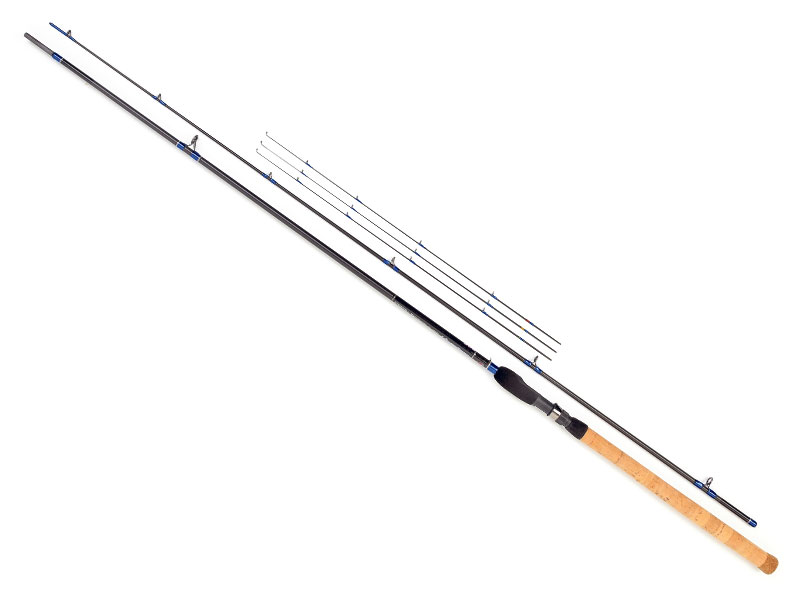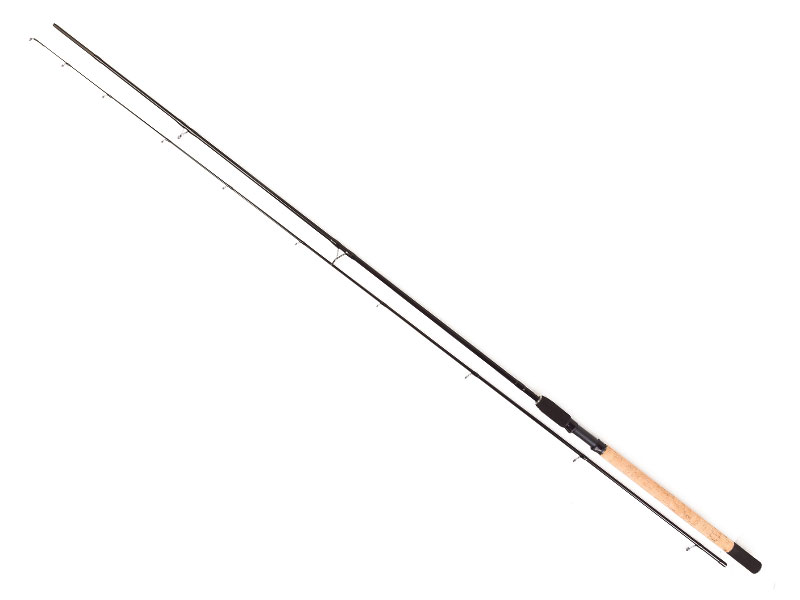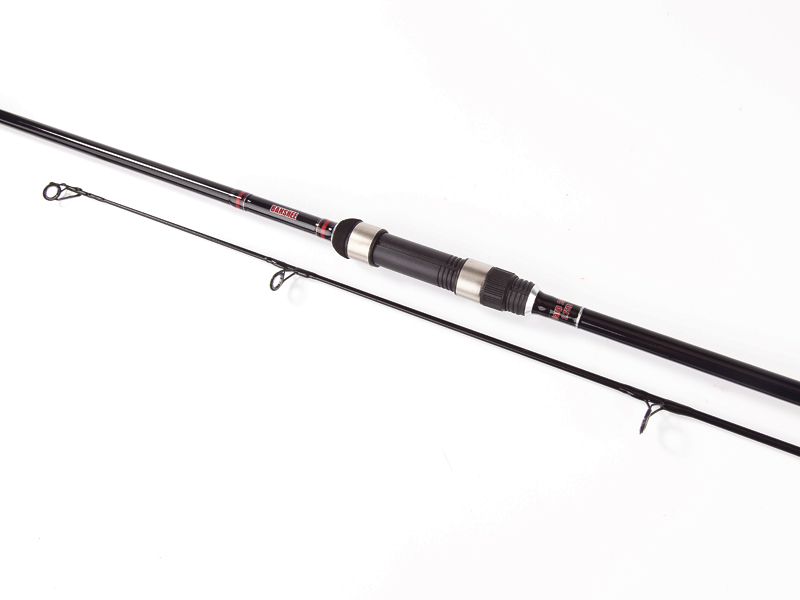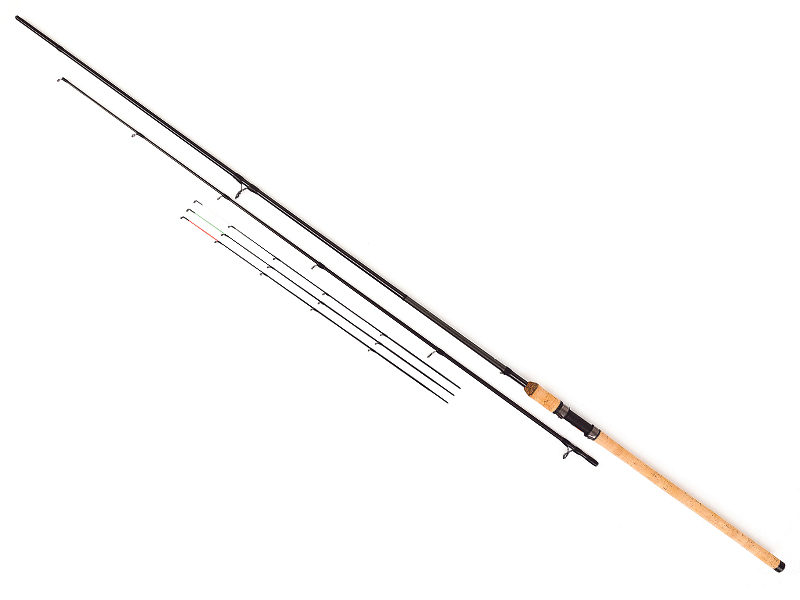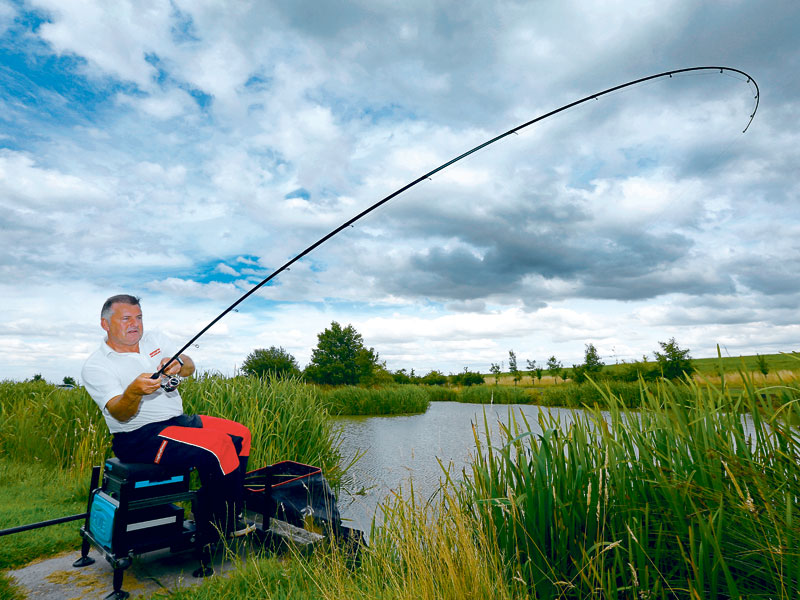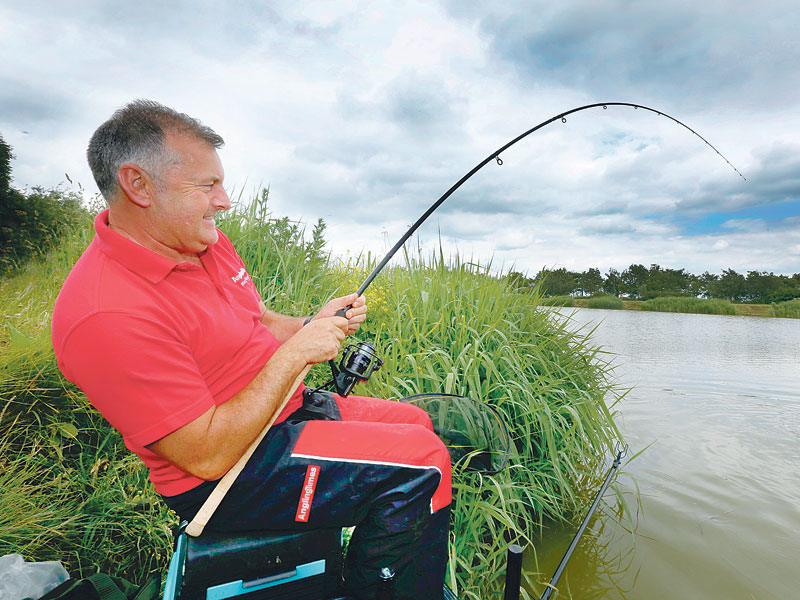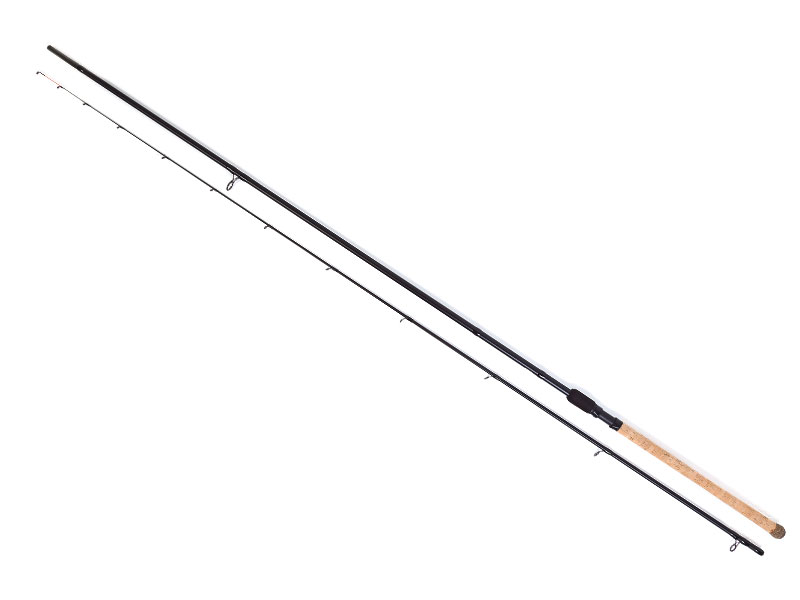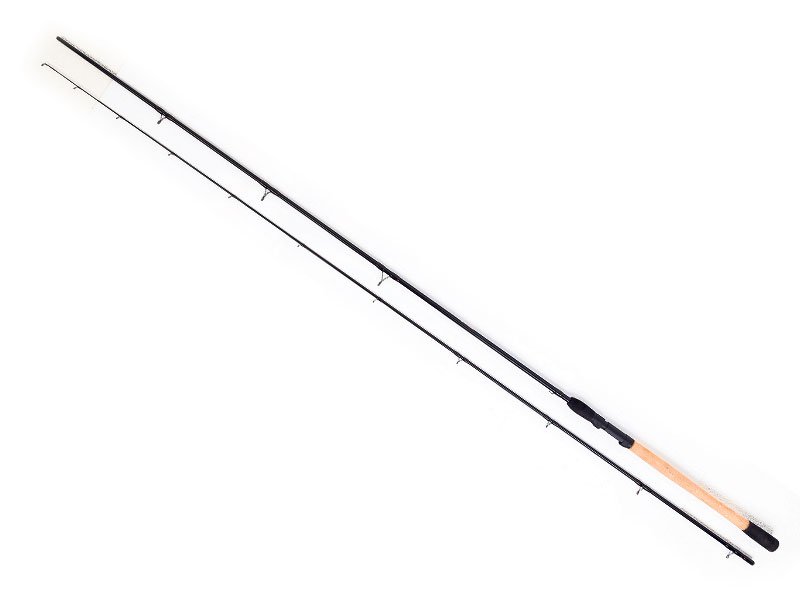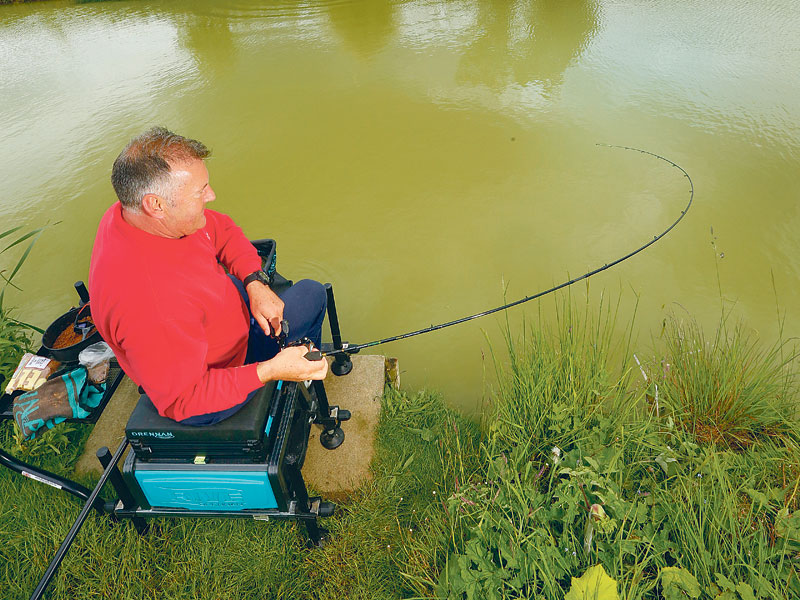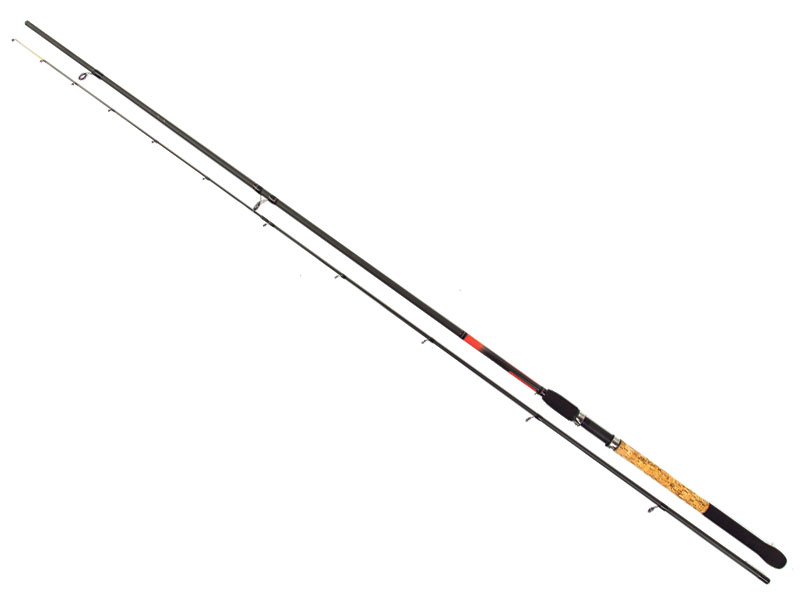Preston Innovations Competition Pro 12ft Medium Feeder rod
PAY AROUND
Preston innovations Competition Pro 12ft Medium Feeder
RRP: £109.99 (but shop around)
PXR Pro 4000 reel
RRP: £104.99 (but shop around)
Not quite as cheap as chips, but more versatile than a Swiss army penknife, is this tasty pair from the Preston stable.
The three-piece 12ft Competition Pro feeder is as much at home dishing it out on rivers as it is battering them down at your local commercial carp venue. The all-carbon blank is nicely put together, and features an old-school full-length 25in cork handle with screw-down reel seat and EVA thumb grip.
Its seamless, flat spot-free progressive action is ideal when targeting big bream, carp, barbel, tench and, of course, chub. The lightweight blank has just about enough softness at its tip to make reel lines of 4lb-8lb with hooklengths down to 0.12mm diameter feasible and, like all good feeder rods, this one has a very high loading point.
This means that when a feeder is attached, the rod only bends from its tip, enabling its backbone to kick in and propel the feeder forward, rather than just lobbing it up and out, as happens when the weight loading area is too far towards the mid-section.
Other features on this Preston rod, which the manufacturers suggest will cast feeders up to 60 metres, are eight low-profile large diameter lined guides. The six equivalent guides on the two spare quivertips also have enlarged diameters, so if you’re off to Ireland, where heavy shockleaders are often used to cushion long casts and protect against zebra mussels, you shouldn’t suffer the annoyance of having the knots catching in the eyes.
The perfect foil for this rod would be its matching Preston branded reel, the award-winning 4000-sized PXR Pro. This model is ideal for winching in heavy feeders and is packed with features including a lightweight aluminium body, quick-release push button spool (plus one spare), precision front drag system, robust stainless steel hollow bail-arm and hard chrome-plated line roller.
Most importantly it runs smoothly and tirelessly on six stainless steel bearings and generates a 4.9:1 gear ratio.
Live testing tackle in winter can be tricky. With the bigger rivers out of sorts, but fed up with bagging commercial carp, where else could I take the Preston pair to prove their mettle? The light-bulb moment eventually came and we were off to Northamptonshire’s River Ise. A stealthy approach using a small cage feeder packed with liquidised bread, and flake on the hook, would hopefully prove successful. The set-up was simple. The reel was loaded with 5lb mainline straight through to a running feeder, stopped with No.8 shot 12in from a size 10 hook. First cast saw the tip tremble, and then it trembled again before pulling round in a classic chub bite. A spirited fight saw a fair sized fish lunging for the nearside reeds, but the 12ft Competition Pro Feeder had a bit too much backbone for any of that old malarkey, and quickly thwarted my quarry’s escape plans.
Through pouring rain, covered in mud, bread and fish slime, both the Preston items performed faultlessly and they get a huge thumbs-up from me.
VERDICT
If there were such a thing as a ‘one-rod does it all’ feeder model, Preston’s Competition Pro Medium Feeder would comfortable pass the test. Every bit as much at home on a commercial carp fishery as it would be bream-bashing on an Irish lough or fishing a big river for barbel, it’s a great all-rounder. As for Preston’s PXR Pro reel, you don’t have to spend long using one to see why the angling public voted it the best reel in its class last year.
Daiwa Harrier Match 13ft rod
PAY AROUND
£54.99
There was a time not so long ago when a three-piece 13ft float rod was standard issue for all match anglers.
Sheffield, Leeds, Rotherham and Birmingham all boasted legions of matchmen whose angling clubs were linked to massive national industries and working men’s clubs. Every weekend would see charabanc outings to the banks of the Witham, Welland, Trent or Severn, where floatfishing was still king and legering came a very poor second.
The best float rods of the day were mainly built on a Golden Jubilee blank, reappearing as WB Clarke’s
All-England, Milbro Enterprise or Billy Lane Match rods.
The first carbon rods weren’t far away, though, and when Fothergill and Harvey’s carbon blank appeared in 1975 they cost a king’s ransom at £133. The early carbon rods, nowhere as good as today’s, cost the equivalent of over £3,000, as much as you’ll pay for a modern flagship pole.
This history lesson earns a place here because 13ft float rods, once the most popular on the market, have evolved tremendously and are available at a steal of a price.
One such model is Daiwa’s 13ft three-piece Harrier Match, which can be found for as little as £44.99.
The rod is built on a decent enough lightweight blank, making it easy and comfy to hold. Its medium-fast action will cast small 3AAA wagglers with no trouble, and it boasts a full cork handle with an EVA lock-down foregrip, lined guides and a matt low-glare finish.
It isn’t the crispest float rod I have ever come across, and it may lack a bit of finesse. But what it can do in spades is handle whatever comes its way – something I was to find out while I was live testing the rod at Boston’s Westwood Lakes.
I had set my stall out for a net of roach and ide, or maybe the odd bream, but the tea-stained Kestrel Lake looked that dirty, I’d have been content to get a bite from anything.
With Storm Imogen racing with unstoppable force across Lincolnshire, this was far from being the best of conditions for floatfishing.
Still, with a 0.10mm hooklength and size 20 red maggot-baited hook on a slow-falling rig, something would surely have a go… wouldn’t it?
It seemed like an age for the bite to come, but eventually it did, and the blaze-coloured float tip sank slowly beneath the surface.
The strike was met by a little more resistance than I had expected, and the rod instantly took on an alarming fighting curve. This action, best described as on the through side of progressive, is pretty much what you want from a float rod if you’re likely to encounter bigger fish.
At first I thought I’d hooked, or even foul-hooked, a carp, hardly what I wanted from a silverfish session, and especially since I was using such lightweight terminal gear.
But as the scrap progressed it became obvious that I had hooked into one of the lake’s legendary barbel.
My balanced tackle was never more welcome than when I slipped the net under a pristine winter Bertram!
The Harrier Match, a long way from being one of Daiwa’s most expensive rods, had absorbed every lunge without my ever breaking sweat that I might get busted up and lose the fish.
Yes, it can be used for small silverfish, but take it from me, the Harrier is capable of an awful lot more when called to battle stations – just like its aircraft namesake, in fact.
VERDICT
On a day when everything but the roach wanted to feed, the Daiwa Harrier proved itself as a great silverfish all-rounder, with enough backbone to cope with much larger quarry when the need arose.
The rod would be well suited to a mixed commercial fishery, where the next bite could come from a matchbox-sized rudd, a powerful carp or, best of all, a belting barbel.
Mark Sawyer
Browning Sphere 10ft Bomb rod
TECH SPEC
Length: 3m (9ft 10ins)
Sections: 2
Max recommended casting weight: 50g
Spare quivertips: 0.5oz, 0.75oz, 1oz, 1.5oz.
Weight: 133g
PAY AROUND
£249.95
Those who regularly read my tackle review pages will be aware that I have been raving about Browning's top-of-the-range Sphere Feeder rods since first clapping eyes on them a year ago.
I adored them at first sight, and was bowled over by their lively, springy and steely feel and seamless non-locking parabolic curves. Live-testing them has proved to be nothing short of stupendous. They have casting power to burn, with recoil-less rigidity matched with a high weight loading area that will propel a feeder or lead a very long distance, even in the hands of a 'standard' distance casting angler like myself.
But - and here's the best bit - somehow the technical boffins at Browning have been able to produce blanks which blend all of that sizzle-factor with an almost imperceptible finesse which only comes into play when you hook a fish. Clever eh?
Faults are hard to find, other than the weight of their price tags, but they are right up there among the best.
Plaudits aside, there was one model left in the Sphere range that I had been waiting patiently to live-test, until the leaves started falling from the trees.
In the comfort of Browning's showroom, this rod felt ideal as a cold-water commercial-fishery tool, ideal for targeting F1s using light lines and small hooks, as well as being able to cope with the odd bigger fish. So as I tackled up on Decoy's unit-packed Beastie Lake, I was hoping for a live test encounter which would live up to my ambitious expectations.
I wasn't disappointed. The first thing you notice is that the blank has a long butt section at 5ft 2ins and a short a (3ft 4ins) carrier section, although when one of its four 23ins glass quivertips are fitted the two sections become equal length, making it easy to carry around as a ready-made.
Browning rates the rod as optimised at around 30m casting distance, which for me was under-gunning its true potential somewhat. My chosen peg was opposite an island end with a paddle type aerator as an added feature. My guess would have been it was around at least a 50m chuck, well above the rod¹s rating, and made even more difficult by the somewhat less than streamlined shape of the 20g pellet feeder I had tied on.
Not a problem! I even had to feather the line a little to avoid an overcast, and once clipped the rod hit the distance every time without fail. All very impressive, but not as impressive as what went on over the course of the next few hours. It¹s called Beastie Lake for a very good reason. Barbel, carp and F1s all grow fat healthy in this fabulous lake, and the Sphere handled them all with consummate ease, even when I had a dabble down the margin.
The resident barbel know every root-end and snag, but the rod pulled them away quickly and cleanly without a creak of complaint. I purposely over-loaded the stress-factor by pulling directly from above in an attempt to make the blank rotate, which in turn makes the guides twist out of alignment but they stayed die-straight throughout the ordeal.
I went through the card with this rod - maggot feeders with small hooks and 0.10mm hooklengths, pellet feeders with heavier lines and hair-rigs, straight lead and pellets - it was faultless. It would happily cope with main lines or braids from 4lb to 8lb and will cast up to 30g weights easily enough. Plus, you can use it with light lines and small hooks as its soft action is very forgiving, so hook pulls are kept to a minimum.
The four push-in glass quivertips are rated 0.5oz, 0.75oz, 1oz and 1.5oz which helps to provide it with sensitivity and durability.
Although it carries a bomb rod tag, the Browning Sphere model shouldn¹t be thought of as an old-school whispish wand designed for winkling out silvers from flooded rivers or canals. It¹s a very modern model with the casting backbone and parabolic fish playing action required for nearly all standard commercial fishery feeder and lead work.
The pencil slim blank has a superb transmission and steely feel, perfectly matched with the forgiving softness that is a hallmark of the Sphere range. If you¹re into the commercial fishery scene then you owe it to yourself to have a closer look.
Daiwa Mission DF Carp rods
PAY AROUND
£125.00
The new Mission DF (Danny Fairbrass signature) models perform well above their price tag. With fittings and furnishings implemented to Danny’s specifications, they feature slime shrink tube handles, 50mm butt guides and a low-glare finish, and are available in 2.75lb, 3lb and 3.5lb test curves.
Daiwa Airity Match and Feeder rods
PAY AROUND
£375-£450
Daiwa has used its tried and trusted Tournament blanks to create this new nine-model Airity series. The extra performance of the latest X45 carbon material is said to offer improved torque and power conversion.
The Airity hybrid 10ft/11ft is every bit as much at home casting a pellet waggler as it is a Method feeder, and will be of great interest to commercial matchman. Look out for an exclusive live test here soon.
E-S-P Terry Hearn Distance rod
PAY AROUND
£249.99
As the water starts to lose its colour, carp seek the solace of deeper water or hidden features.
This is when you need a rod that will hit the horizon, and E-S-P’s latest Terry Hearn Distance rod does just that.
The 3.5lb test curve, two-piece 12ft 6ins carbon blank boasts top-end single legged SiC guides throughout – including a 50mm butt guide – a full-length slim EVA handle and a Fuji DPS reel seat with flared collar. In the right hands it will cast accurately over 100 metres
Tri-Cast Trilogy 11ft 6ins Commercial Waggler rod
TECH SPEC
11ft 6ins version
Casting weight: Up to 20g
Line rating: 2lb-6lb
12ft version
Casting weight: Up to 30g
Line rating: 2lb-8lb
PAY AROUND
£179.99
This new two-piece 11ft 6ins Tri-Cast Trilogy Commercial Waggler rod offers the keen match angler something rather different to the usual 10ft, 11ft or 12ft rods of this general type.
It is quite capable of casting pellet wagglers up to 20g, but it can handle lighter straight wagglers from 3AAA upwards just as well.
When you first pick up the rod the pencil-slim carbon blank feels a little too light in the hand, and you could be excused for thinking that it would be best suited to F1s, small carp and big silvers, rather than ‘proper’ carp. However, you would be mistaken – as I was after a few hours of boisterous activity on Cedar Lake at Peterborough’s fish-packed Decoy Lakes.
The latest Tri-Cast model took on and beat everything thrown at it, from double-figure carp to barbel almost as big and twice as aggressive. Yes, this rod really is a wolf in sheep’s clothing.
The progressive action has a wonderful degree of elasticity that enables it to bend almost double when put under heavy stress, but there is no suggestion of twist along the guides. The blank simply soaks up the punishment, and what’s more it’s great fun to fish with.
With its low-profile guides set off by bright blue gloss whippings it’s a bit of looker into the bargain.
VERDICT
Don’t imagine that this new rod is nothing more than another version of Tri-Cast’s famed XRS-2K4 model. The Trilogy Commercial has an altogether different fish-playing and casting action, not to mention looks and feel.
It would also make a better ‘all-rounder’ as its lightness and elasticity make it a very versatile rod indeed.
Mark Sawyer
Tri-Cast 11ft Trilogy Feeder rod
TECH SPEC
8ft version
Casting weight: Up to 20g
Line rating: 2lb-6lb
10ft version
Casting weight: Up to 25g
Line rating: 2lb-6lb
11ft version
Casting weight: Up to 30g
Line rating: 2lb-8lb
PAY AROUND
8ft £145.99
10ft £182.99
11ft £196.99
Who remembers (and probably laments the passing of) Carbotec Fast Play Feeder rods? They were so good that they retain their old face value, or even more for the right model.
This new Trilogy Commercial Feeder shares more than a few of its traits. The two-piece blank is probably a bit lighter and slimmer, and doesn’t have quite the same degree of casting clout, but it still has an extraordinary amount of fish-playing elasticity. There’s not a sign of flat spotting, nor does the rod form anything other than a perfect hoop when put under strain. The more you pressure it, the better it gets.
The casting action has a fair bit of hidden backbone spliced into it, and the 11ft model on test threw a 40g flatbed Method feeder more than 40m with little more than a swish.
The rod comes complete with light, medium and heavy push-in carbon quivertips that do nothing to mar its seamless flat-free fighting curve – very commendable of Tri-Cast.
But why on Earth they didn’t add an inch of blaze-coloured paint to the end of each quiver defeats me. Irritating, but that small detail wouldn’t stop me buying one.
VERDICT
I can’t wait to try the shorter 10ft version of this Tri-Cast rod.
I have a feeling it just might be the ultimate snake lake, small pond F1 and big-fish lead rod.
Meanwhile the 11ft model on test casts straight and well, is light in the hand, and has what seems to be a limitless supply of progressive fish-playing clout – it’s pretty special.
Mark Sawyer
Browning Commercial King Micro Waggler 9ft rod
PAY AROUND
£49.95
Fish on commercials are in the mood for food. They’ll pounce on virtually any bait, and even the crudest tactics will catch them.
But all too soon, as autumn arrives, everything changes. To succeed in cooler water a polished and more refined style of angling is needed, and you need to think very hard about your fishing to carry on reaping the rewards.
Finer lines, smaller hooks and smaller baits are all part of the equation, but to match the finer end tackle you need a suitable rod– and this is where Browning’s latest Commercial King Micro Waggler puts in an appearance.
With its abbreviated length, this nine-footer is obviously tailor-made for short-range casting on small commercial pools and snake lakes, rather than wide expanses of water.
But don’t let its lack of inches mislead you into thinking it’s probably a bit too short to handle anything weighing more than a couple of pounds.
The super-lightweight (160g) two-piece carbon blank dishes out more than enough clout to cope with the odd beastie or two.
Ideally, though, the Micro Waggler should be paired with a 2500 or 3000 sized reel loaded with a good sinking 4lb mainline, and used in conjunction with wagglers weighing no more than 15g. With such a set-up, the rod would be ideal for all maggot and 4mm-6mm pellet hookbaits with appropriately sized hooks and hooklengths.
The pencil-slim blank has a fabulous action that allows it to bend through most of its top section, with plenty of power feeding in via the middle and butt, just perfect for putting carp and F1s on the float in their place.
When it comes to playing and landing bigger fish on a shorter rod you’ll be pleasantly surprised – the reduced length seems to give you more leverage, and quickly brings them within easy range of the net.
Casting accuracy is good too (leaving aside ‘operator error!’), making it ideal to work with in typical parrot cage swims hemmed in by reeds.
In the right hands it will cast 35 yards-plus but, as you might expect, line pick-up at this distance isn’t the fastest.
This rod is at its brilliant best when presenting a waggler with precision just beyond your pole line.
We tested our sample rod at Decoy Lakes’ very scenic Willows Lake which is jam packed with F1s, with the odd bigger fish to keep them company. These larger carp have seen it all before, and can prove frustratingly difficult to nail. The best way is to feed 4mm pellets little and often – these fetch them up in the water pretty quickly. Then it’s a case of picking out your target, taking aim, and landing the banded bait right in front of the fish. Sooner or later one will turn and swirl on the bait, giving an instant and very often explosive take – exciting stuff. It’s really dobbing with a waggler, and patience and accuracy are key.
Now I can’t vouch for your patience, but I certainly can vouch for the casting accuracy of the Browning Micro Waggler!
VERDICT
This tiny waggler rod may seem a bit of a specialist tool, but when it’s too windy for the long pole it comes into its own. With its unerring casting accuracy it’s also ideal for far-bank snake lake work.
Mark Sawyer
TF Gear Banshee carp rod
PAY AROUND
£59.99
TF Gear’s latest 10ft Banshee carp rod is said to be able to catch carp from just about any type of venue.
In test curves of 2.75lb, 3lb and 3.5lb, the blanks are built from quality carbon fibre and furnished with premium grade silicone-lined guides and screw-down custom DPS 18 reel fittings.
The fish-playing action is progressive, and these rods look as if they are built to take a lot of stick.
Middy Nano-Core XZ65 World Elite 10ft Feeder rod
TECH SPEC
- Three special blank graded carbon push-in quivertips of 0.5oz, 1oz and 1.5oz test curves ensure a flat spot-free action, and make the rod suitable for a multitude of feeder applications.
- The rod comes with an original Middy aluminium hooded reel seat ideal for most reel sizes.
- The super-slim 20ins full cork handle makes the rod comfy to hold even when it’s under stress.
PAY AROUND
£209.99
Middy produces some mighty impressive commercial fishery rods these days – everything from short snake lake models to horizon-hitting beasts.
What’s more, there’s something to suit everyone’s pocket.
At the very pinnacle of Middy’s feeder rod range sits the new 10ft Nano-Core XZ65 World Elite, yours for a jaw-dropping £293.99. But panic not, as it can be found at a more realistic price if you shop around.
That said, it’s still a lot to lay out by anyone’s standards, so what exactly would you be shelling out for?
Well, for starters you get an ultra-slim (just 11mm at the butt section), ridiculously light, two-sectioned carbon fibre blank, the result of the very latest Nano-Core technology. This translates into a rod with lightning-fast reflexes, immense strength and flexibility.
The blank has undergone a unique high-pressure vacuum curing process that forces out any tiny air bubbles, ensuring a consistent performance and a flawless finish.
Other luxury touches include three push-in carbon quivertips rated at 0.5oz, 1oz and 1.5oz, seven ceramic-lined double and single SiC Ultra-Flow guides, and a thin full cork handle furnished with a screw-down reel seat.
Middys claims the rod will cast bombs and feeders up to 50g with mainlines up to 12lb and hooklengths up to 8lb.
So far that’s pretty much standard manufacturers’ marketing speak for a commercial feeder rod of this ilk. But in my humble opinion top-end or flagship models should always have that bit extra, the ‘wow factor’ if you will...
You’re already paying for the classy furnishings, fittings and carbon technology, but without that noticeable edge to the rod’s performance all that counts for nowt – and that applies to all tackle brands, not just Middy.
And so to the live test. A favourite water of mine is the peaceful day-ticket Stretton Lakes, just off the A1 north of Peterborough. The fish here are of an average size, and respond to most open-water tactics – ideal helpmates for tackle testing.
Assembling the rod, you cannot help but be impressed by its pencil-slimness – in fact I found the full cork handle a tad too skinny for my own assortment of butt rests, and would suggest that any prospective buyer should look for a small U-bend abbreviated rear rest of the sort favoured by carp anglers.
The sections are not quite equal in length when the carrier section has a quivertip in place, so you need to be extra careful when you’re putting it away ready made-up, even though the classy Middy padded carry bag is more than long enough for the job.
I was not wholly convinced by its suggested 50g maximum casting weight. For me, the top end of the carrier section has a little too much play, and while there is no denying its impressive post-cast recovery speed, this rod is clearly not of the ‘give it a whack’ breed – face it, if you miscast and take out the top section that’s a very expensive mistake to make.
And there end my criticisms. The fact is, the performance of the 10ft World Elite will have you purring with satisfaction. It has a wondrous amount of torque and feel, with a handling aptitude right up there with the very best.
The immaculate gunmetal grey blank has a phenomenal pick-up speed, and its responsiveness to any size of hooked fish actually takes a bit of getting used to. It’s a bit like stepping straight out of your old family saloon and into a works rally car, but once you adapt to the change it’s all systems go – only you won’t have to strap yourself in!
VERDICT
A genuine high-performance rod for the commercial fishery connoisseur, this top-end Middy model will handle most weights of flatbed feeders and straight leads up to 40g (1.5oz). It is equally at home using a maggot feeder with light lines and small hooks for F1s as it would be targeting much bigger fish with bread discs in winter.
Mark Sawyer
Daiwa Harrier Match Pellet Waggler 11ft
TECH SPEC
Full cork handle
Eva down locking fore grip
Matt low glare finish
Light balanced blank
Medium fast actions
PAY AROUND
£49.99
What could possibly prove to be as popular as Daiwa’s TDR and Yank N Bank rods?
Strong contenders must be the 10ft, 11ft (on test) and 12ft Pellet Waggler rods in the new and very affordable Harrier range.
All eight models are realistically priced to put them within reach of anyone wanting to own a Daiwa rod but not blessed with infinitely deep pockets.
That doesn’t mean that the blanks used in their production are in any way inferior, or have cheap fittings. In fact, judging by the test sample sent in to me at Angling Times it’s as though the company has taken extra care to ensure that these bargain-priced models meet Daiwa’s usual high standards.
They all boast a low-glare matt finish which gives them a nice hand-built look, the full cork handles have reliable locking EVA foregrips, and along the blanks are correctly positioned double and then single-leg lined guides which contribute to a medium-fast, progressive action with no flat spots.
Okay, I wouldn’t bet on them being made from the finest high modulus carbon fibre cloths, but these graphite-built beauties feel light and well balanced, with no wobble and a crisp post-cast recovery.
However good a rod may look, the acid test is how well it performs, and a few hours spent throwing around a variety of pellet waggler and splasher floats confirmed the 11ft Harrier Pellet Waggler’s suitability as a cracking small to medium-sized commercial fishery tool.
It is more than comfortable handling floats from 4g up to 10g and reel lines from 6lb-8lb but it’s – let’s say – just a little too ‘manly’ for anything much lighter in the float department.
The fast tapering two-piece blank generates a surprising amount of power, certainly considerably more than I had seen up until now from a graphite-built rod. It’s not overly pokey, it doesn’t feel in the least like a broom handle, but it’s quite a muscular caster. Don’t be afraid to give it a fair old overhead whack to punch out a float against a headwind.
Fish are dealt with quickly and efficiently too, something I found particularly useful when needing to guide lively 3lb-5lb carp around the tackle-wrecking thick reed beds surrounding Sallow Lake on the day-ticket Homeclose Fishery in Rutland.
If you regularly visit a snaggy venue holding big carp that respond well to float tactics, this could be just the rod you’ve been looking for.
It’s built to take the odd knock and bounce back unscathed, and at a penny under 50 quid it really is a steal.
VERDICT
Daiwa has dressed this rod to look like one costing three times the price. Well suited to bigger commercial fisheries, the blank delivers ample fish-playing power and casting clout, but its carefully crafted carbon and glass construction and fast tapering design prevents it from being overly aggressive.
Mark Sawyer
Free Spirit Surface Creeper 'E' 11ft rod
TECH SPEC
- Perdurable blank finish
- 40T carbon weave
- Free Spirit machine-cut aluminium reel seat ion-plated with a blue-grey finish and with a milled isotope slot available as a build option - please enquire
- S-Lite 3-leg rings
- Fuji DPS reel fitting
- Full EVA handle
- Ring sizes (mm): 30 to 8
- Custom build options
- S-Lite tip ring designed to minimise the chance of tangles (and crack-offs) on the cast.
- The Fuji DPS 18 reel seat is light, ergonomic and totally secure – reel seats don’t get much better than this.
- The test rod came with a full EVA handle, but there are cork and shrink tube options available as well.
PAY AROUND
£109.99
Disappointing summer fishing weather is as British an institution as mother-in-law jokes – and has about as much grounding in fact.
More typically, the sun will put his hat on – and that’s when big carp show an interest in floating baits.
Surface fishing can be thrilling yet frustrating as every single bait (except the one with your hook in it) slips silently under the surface, seemingly drawn inexorably downwards by an unseen magnet.
Tricky and nerve-tingling, fishing with floating baits is stalking at its most primeval level – man pitting his wits against crafty fish that have seen it all before. It can drive you half mad. “Why won’t they take my bait?” you ask a passing moorhen as you strike far too late at yet another half-chance.
But when it all goes right, as it did when I live-tested the two-piece 11ft Free Spirit Surface Creeper ‘E’ on Mitre Pool at Bishops Bowl fishery in Warwickshire, all the earlier frustrations are quickly forgotten.
This specialist floater tool has a soft, sensitive tip suited to small controllers and light nylon hooklengths. It is also more than handy for margin stalking and freelining.
The classy chequered 40 tonne Perdurable (non-scratch) all-carbon blank is typical of the aspirational Free Spirit brand. With understated white graphics on the butt section, a Fuji DPS 18 reel seat and braid-friendly S-Lite guides throughout (starting with a 30mm butt guide), the rod on test had a full EVA handle, although full cork or full shrink tube options are available for a small additional charge.
In action, the Surface Creeper ‘E’ takes the biscuit – as indeed do the carp it snares. No, it doesn’t have the casting clout to belt out a weighty controller 100 yards, but it wasn’t built to do so. However, it will cast smaller floats up to 20g well over 50 yards with ease, making it an ideal choice for medium-sized lakes and pits. Its tippy action will flick out a freelined mixer a fair old way, as long as you’re using light reel line.
The live test went well, and the rod’s L plates were off in no time at all.
Feeding some freebies, then hiding away behind some reeds, gave the carp confidence, and soon one made the error of slurping down a mixer with a hook attached. Quick as you like the Surface Creeper took on its full fighting curve, best described as all-through but with steel running through the mid-section. This gives the soft-tipped blank enough poke to deal with hefty lumps without it feeling overgunned.
Soon a scale-perfectmid-double mirror was laid on the unhooking mat… don’t you just love it when a plan comes together!
VERDICT
What a month for live testing fishing rods it’s been! First came Browning’s awesome new 12ft Sphere Feeder, the ultimate bream rod. Then it was the 11ft Free Spirit, perfect for surface fishing with its soft, forgiving tip that allows it to be used for freelining mixers or controller work. It’s ideal for all but the very largest open-water venues.
Mark Sawyer
Shimano Tribal Velocity rod
PAY AROUND
Full range from £139.99 to £159.99, currently retailing from £64.99 to £79.99
Shimano’s latest offer is one to turn your head. These 12ft, 2.75lb test curve Tribal Velocity rods, which used to retail at up to £149.99, are now just £69.99, or £199.99 for a set of three.
For that you get ultra-slim blanks and Japanese shrink-wrap handles, double-leg guides and anti-wrap tip guides. There’s also a built-in line clip and a ‘rod pod stopper’ to secure the rods on your rests.
A compact Shimano reel seat completes the package.
Browning Sphere Feeder M 3.90m rod
PAY AROUND
£249.95-£399.95
Browning’s new Sphere rods are aptly described by the European tackle giant as being ‘from a different world’.
Made from the very highest quality carbons, every aspect of their design is engineered to produce a finished product that is as near perfect as it can be.
The Sphere blanks are said to be the slimmest and lightest high-modulus carbon rods available, and features include superb ultra-low-friction ‘skeleton’ SiC guides throughout, plus an ergonomic, weight-reducing handle which transmits more ‘feel’ through to the angler.
Between them the seven Sphere Feeder models cover every possible aspect of feeder fishing, from lightweight two-piece silverfish models through to 4.2m (13ft) firm-actioned rods capable of handling heavy leads in raging torrents.
Browning claims the rods will add yards to your cast, yet remain responsive enough to safely play soft-mouthed fish like skimmers and withstand the thumping head-shakes of really big bream without fear of hook-pulls.
That is quite some claim. I have seen and used many really good bream rods in my time, but nothing has ever been absolutely perfect – until now, that is!
From the moment I first handled these rods in Browning’s German factory I knew they were a bit special. The first clue to their excellence came during a conversation I had with Bob Nudd at this year’s Big One show. Bob excitedly handed me one, proclaiming: “This is the best feeder rod I have ever seen.” Praise indeed from a five-time World Champ with a lifetime of match and festival wins.
Recent sellout match attendances at open-water bream venues such as Peterborough’s Ferry Meadows had brought me a spate of ‘which rod?’ emails. These, along with questions from anglers on the bank asking about distance feeder rods, were all the excuse I needed to ask Browning to send in a Sphere for review.
This they duly did, and I received a 3.90m (12ft) three-piece Feeder M that I was assured would be ideal for long casting to big bream in open water.
Now, let’s clear one thing up, these rods are eye-wateringly expensive, with prices from £249.99 right up to £399.99, so you would expect them to be more than reasonable. However, they do come with four matching push-in tips which offer the ultimate in bite detection.
Settling into permanent peg 127 on Ferry Meadows’ Overton Lake, it was time to get some bait in. Clipped up at a modest 60 turns on the 4000-sized reel, the rod delivered a fully loaded 30g feeder bang on to the spot every time. Even a niggling headwind did nothing to affect accuracy or distance.
After 20 minutes of constant casting to get some feed out, I unclipped the reel, tied on a heavier feeder and unleashed the beast – ‘awesome’ is the only the word that does this rod justice.
The power kicked in through the middle section, the carrier was virtually recoil-less, and 90 turns later the feeder was back in my hand. Now I wouldn’t claim to be the best caster around, probably only just better than average. But never before had I chucked a feeder so far with so little effort.
But would this rod prove too stiff to play a big bream on? We’ve all been there – up pops the feeder, the bream starts shaking its head, and the rod doesn’t cushion the weight of the feeder being tossed around, so out comes the hook.
It’s the saddest sight in match fishing, staring at an empty landing net head with a big swirl behind it.
Suffice to say, this rod handled the situation with consummate ease – every fish was brought to the net early, apparently increasing the likelihood of a hook-pull, but everything stuck fast.
I could go on and on about the virtues of this rod, but I’ll leave you with this thought… don’t buy any other distance feeder rod until you have seen a Sphere.
VERDICT
Without doubt these Spheres are the best rods Browning has ever produced. Casting with breathtaking performance and accuracy, they have unequalled fish-playing powers, and are aesthetically unlike any others. If the rest of the Sphere Feeder series is anywhere near as good as this 12ft medium test model than Browning has created something out of this world.
Mark Sawyer
Matrix Method Master 11ft Feeder rod
TECH SPEC
In this range, there is a choice of 9ft, 10ft, or 11ft, all with casting weights of 20gms to 50gms.
• High modulus carbon blank.
• Semi-parabolic fish-playing action.
• Designed for up to 25m.
• Casting weight: 20gms - 50gms.
• Ideal for fishing the method on the pole line of on snake type lakes.
• Short handle for easy manouvering when casting and playing fish.
• Lightweight, strong double and single leg guides positioned for easy made-up transportation.
• Cork/EVA handle with soft-touch screw down hood reel seat.
• EVA transport holder block holds all sections parallel for easy made-up transport.
• Ideal for all method feeder\pellet feeder fishing.
• Rods break down into two equal lengths.
• Supplied with two (3/4oz, 1oz) interchangeable tips.
• Line rating 4lb - 8lb.
PAY AROUND
9ft £59.99, 10ft £64.99, 11ft £69.99
Matrix has added three new Method Master feeder rods to its range designed to tackle commercial fisheries.
In 9ft, 10ft or 11ft lengths, all three blanks will cast Method feeders weighing between 20g and 50g (0.7oz and 1.7oz), which will cover nine out of 10 pools you’re likely to find yourself pegged on.
At a time when quality short feeder rods can set you back a considerable chunk of wedgeit’s quite refreshing to find that these superbly appointed rods can be had at under £70 a chuck.
So, what’s the catch – if indeed there is one? To find out, and hopefully make a decent catch of my own, I settled into a peg fringed with Norfolk reed on the day-ticket Kingsland Reservoir, just outside Peterborough, equipped with the 11ft version of the Matrix Method Master.
The fish in this deep lake – mainly carp – show a definite taste for baits presented on the Method, especially close in to the margins. This tactic obviously doesn’t test a rod’s casting attributes, but it does put its fish-playing mettle under the spotlight.
Before you even wet a line, one of the first things you will notice when putting together the two equal-length sections of this 11ft blank is its fast taper from butt to tip.
This gives it a high weight loading area toward the tip end of the carrier section and enables the rod to hold pretty much rock-steady before casting.
There’s none of that bouncing around of the feeder that can be such a pain in the butt section – yours!
This lack of movement improves the rod’s distance casting and accuracy, and after half-an-hour of trying out different weights of feeder I can happily report that it will handle 30g flatbed models with very little effort. That said, I felt that the manufacturer’s recommended maximum casting weight of 50g would be overstretching the rod.
No matter, the plus points way outstrip this small negative. The blank is a composite of carbon, glass and resins which together produce a rod lacking in flat spots, and with enough backbone and grunt to tame the odd Barney Rubble.
This rod is immensely enjoyable to use. Bend it like Beckham and it will put fish in the net time and time again.
Indeed, if you’re into your commercial match fishing, it should help you score a good few points over the opposition.
VERDICT
The new Matrix Method Master casts accurately and sufficiently far to cope with the majority of commercial fisheries. The equal length two-piece blank has lots of feel and transmission, and its controlled progressive bend will cope with fish big and small.
This very affordable rod can be used with reel lines between 3lb and 8lb, and is destined to become a firm favourite with all club match anglers on a budget.
Mark Sawyer
Preston Innovations 12ft Pellet Waggler rod
PAY AROUND
£169.99
This 12ft Pellet Waggler rod is the latest addition to the best-selling Carbonactive Mini Plus commercial range from Preston Innovations.
Honed to perfection for casting splasher-type floats and big pellet wagglers on open-water venues such as Viaduct, Barston and Meadowlands, this rod was developed with input from talented match angler Andy Power.
Andy can list wins in the Maver Match This and UK Champs, as well as qualifying for three Fish O’Mania finals, in a long line of achievements.
In a chat I had with Preston’s brand manager Scott Geens about the ins and outs of the blank’s construction, he told me that Andy had netted fish to over 20lb from Viaduct during its field trials, so no worries on that score!
I was lucky enough to be given an exclusive preview of the new Preston tool, and I never pass up the chance of chucking a big pellet waggler around – besides, the sun was shining.
So I found myself pulling up in the car park of the Canal and River Trust’s day-ticket Engine Pool on the Earlswood complex, armed with little more than a few bags of 8mm pellets for bait and feed, and a box of distance-casting wagglers.
Engine regulars will know just how fickle this water can be. It’s very much feats or famine, but with rock-solid information that the pegs in the high 70s were rammed with fish, my confidence of nailing some proper lumps was riding high.
It was less buoyant after three-and-a-half hours of constant casting and feeding, feeding and casting, swapping between wagglers of the splasher, pellet, clear, loaded and unloaded kind, even some with popper discs.
Having gone through every permutation of floatfishing up in the water, all I had to showfor my endeavours was sore knuckles from what must have been a thousand raps from the pouch of my catty.
You could say my interest was flagging somewhat.
My photographer, Lloyd, had taken to doing ‘wildlife’ snaps – well, that’s what he called them, but I never realised that insects wore Lycra shorts and went jogging round lakes!
With time pushing on, what had I learnt? Well, the Preston 12ft Pellet Waggler rod has quite a fine tip for what is basically an animal tamer.
It will cast just about anything you care to tie on to the reel line, bar possibly a bagging waggler – anything else isn’t a problem.
Even the largest vaned pellet waggler from John Bonny (the Mad Hatter of float makers) can be cast completely out of sight.
I had matched the rod with a 6lb reel line – with 8lb your casting distances would suffer as the guides are all of standard match size to handle thinner diameter lines better. I’d recommend you to play your cards right and stick to 6lb line, not going higher or lower.
Then it happened. The float landed with an angel’s caress, to be greeted with a swirl as an Engine Pool brute couldn’t resist what was obviously my above-standard banded pellet presentation – or perhaps it was down to the fact that it was now getting dark. It matters not – the blank swept the line up in a none too sloppy manner from the surface, then kicked into its progressive fish-playing action.
Now I could finally see the benefits of all that field-trialling. Yes, the rod has unbridled power, but it’s all been channelled into the blank’s middle section. When you lean into a fish it absorbs then dictates… you know you’re in charge.
It’s a strange thing with carp that sometimes, if they feel they are on the losing side from the start, they all but give up. Right at the net, the Earlswood projectile made a half-hearted bid for the legs of the platform, but a smart side swipe from the rod brought it straight up on top and into the pan.
How good is that?
VERDICT
This classy rod from the Preston Mini Plus stable has plenty of brutish power tempered by just the right amount of finesse, and the build and finish are both top-notch.
It’s quite capable of dealing with the largest of fish, but it’s fun to use and sure to become a favourite with anglers visiting big open-water venues this summer.
Mark Sawyer
Browning Commercial King 8ft F1 Wand
TECH SPEC
Length: 8’/2.45m
Sections: 2 + 3 Tips
Casting weight: 2 – 4 lbs
Travel length: 1.27m
Weight: 150g
PAY AROUND
£59.99 both models
If you feeder fish snake lakes that don’t require massive casts then this wicked little rod should have your name on it. And here’s why…
Browning has further improved and refined its Commercial King Rod range to include these two gossamer 8ft Carp and F1 Wands, both of which eradicate hook-pulls while having the capability to land any big bonus fish.
The pencil-slim, through-actioned blanks bend all the way from their tips through to their cork handles. The F1 model, on live test duty, has the more forgiving action and is rated at around 20 per cent softer than the slightly beefier Carp Wand.
I favour short rods with actions like this because they can transmit every flick and flutter from fighting fish of all sizes, yet effortlessly cushion the most fragile hooklengths and tiny hooks.
They allow an angler to present really light rigs to finesse bites from shy-biting winter F1s and skimmers that have seen it all before, and they more than justify the asking price for use on hard winter commercials, where you might be fishing for just half-a-dozen bites in a match. Their reduced length allows you to easily tuck them out of harm’s way down the side of a platform, well out of the wind.
The F1 Wand is built to fish with reel lines of 2lb-5lb, while the Carp model can handle slightly heavier mono from 3lb-8lb, with appropriate hooklengths, but I wouldn’t go much below 0.10mm even with the F1 version.
I paired my test rod with a 4lb mainline that blended sweetly with the two-piece, 8ft blank. Three fine glass quivertips of 0.5oz, 1oz and 1.5oz come with each rod. These will register delicate bites while still managing to accurately throw feeders and bombs of up to 2oz. Reduced length rods are reckoned to give much greater accuracy over long ones when making the short-range casts required on many commercials these days. They’re also definitely easier to use in tight swims hemmed in by vegetation.
I took the test rod to the prolific Greensands snake lakes fishery near Sandy, in Bedfordshire, to fish a small 15g flatbed feeder loaded with dampened 2mm pellets and fine fishmeal goundbait with a 6mm hair-rigged banded pellet and size 16 hook.
The first thing you notice is how light the Browning Commercial King F1 Wand feels. The next is how easy it is to cast overhead, plopping the feeder accurately hard up against the far bank, or features such as islands or aerators, at distances from just beyond pole range to around 30 yards. On many day-ticket venuesbeing as little as 12ins off target makes all the difference between a good day and an average one.
No worries – it’s my bet that with this pint-sized belter sitting on your rod rest, you’ll be bang on the money every chuck.
VERDICT
This super pair of 8ft Wands from the Browning stable are ideal for commercial snake lakes and small pools. The F1 model, in particular, would be hard to better for this kind of fishing. It would make an exceptional winter maggot, feeder and small-hook F1 tool.
Mark Sawyer
Shakespeare Sigma 10ft Commercial Feeder Rod
The Shakespeare Sigma Commercial rod range features two-piece carbon blanks with powerful, but progressive, actions. These rods are designed to allow for accurate casting and making the playing of hard-fighting fish easier and faster.
THE RANGE
Sigma Commercial 11ft Float
Sigma Commercial 10ft Float
Sigma Commercial 11ft Feeder
Sigma Commercial 10ft Feeder
PAY AROUND
£39.99
Every match or pleasure angler who catches big fish on commercial pools should have a rod like this in their holdall.
Carrying a full recommended retail price of just £39.99 (although you’ll find it even cheaper if you shop around a bit), it’s eminently affordable.
With two equal-length sections, the 10ft rod is easy to carry ready rigged for action. Its composite carbon and glass construction generates a fast casting action, and it plays fish firmly yet forgivingly.
I was soon to experience its qualities at close range as I ran the rule over this Shakespeare 10ft Feeder, part of the famous firm’s new four-rod Sigma Commercial range.
The kind of venue I would choose for a feeder/lead rod of this type is a small to medium-sized commercial pool of between 20 and 40 pegs, with required casting distances of 15m-40m. The open-water strip lakes at fish-filled Decoy Lakes near Peterborough fit the bill perfectly, and so armed with some timely advice from Angling Times deputy editor Kevin Wilmot, I aimed for a peg at the top end of Oak Lake.
A few exploratory casts down the lake with different weights of feeder confirmed the casting credentials of the new Sigma, which are amazing for such a short rod. The fast tapering blank has a high weight loading point, matched with impressive poke from its butt section, and will cast feeders and straight leads of up to 40g more than 35 metres. This is more than enough for most commercials.
My casting target on the day was actually little more than 25m, enough to position a 15g flatbed Method feeder tight up against the only feature in the lake, a paddle-type aerator. Pinpoint accuracy was needed, and the sparky little Sigma didn’t disappoint.
The blank is recommended for use with reel lines up to 8lb – quite heavy, in other words – and hooklengths from 0.12mm upwards.
The rod’s most outstanding asset, though, has to be its splendid progressive action. Far from being wetter than a haddock’s bathing costume, it manages to blend a soft tip with a fast-tapering mid-section, which makes the playing of big fish quick and easy, never stiff or overpowering.
My first fish of the day proved the point when the quivertip (two graded carbon tips of 1.5oz and 2oz are supplied) slammed round hard as a big kipper made off with my double corn hookbait. The rod did its job nicely, absorbing every lunge and run all the way to the net.
This is normally when most big fishtend to come off the hook, but not this time! The blank kept the fish under close arrest without any worries that it was about to slip the handcuffs and escape.
VERDICT
A very impressive rod from Shakespeare, and impossible to fault, given such a low asking price. It casts well, has a super power-playing progressive action, and could turn its cork handle to conquer most feeder and straight lead commercial fishery situations.
Mark Sawyer
Middy 4GS Micro Muscle Waggler Rod
TECH SPEC
- 11ft Super slim Supplex high-modulus carbon two-piece blank
- Soft-touch EVA thumb grip
- Ergonomic lock-down reel seat
- Hook retainer
- SIC Feather-Lite gunsmoke guides
- Max mainline 12lb
- Max hooklength 8lb
- Casting weight 25g
PAY AROUND
Price (RRP): £139
Shop-around price: £99.99
I take my hat off to Middy, and I’ll tell you why. Not that long ago, very few serious matchmen would have believed the Derbyshire firm capable of producing commercial fishery pellet waggler and float rods to the high standards they demanded.
However, that’s all water under the bridge. Since Middy introduced its original, superb and hugely successful X Flex 3G Pellet Waggler rod series the company has firmly established itself as a market leader for rods of that ilk.
The all new Middy 4GS offerings definitely continue the tradition, with several key improvements, including Supplex carbon technology.
This leads to a refined tip action, allowing fish to be landed even more quickly, as extra power is available through the butt section without risking hook-pulls or snapped hooklengths. Other improvements include an upgraded, progressive fish-playing action and better handling and balance.
All very impressive – but why would Middy need to make changes to a model that was voted rod of the year a couple of seasons back?
Any doubts along the lines of ‘has Middy mended something that clearly wasn’t broken in the first place?’ were all laid to rest as I spent a few hours putting the new 11ft 4GS Micro Muscle Waggler through its paces at Oakfield Fisheries’ day-ticket Red Kite lake.
The ultra-wary carp in here grow big, really big… which is handy, as the new Micro Muscle is rated more than capable of dealing with zoo creatures into double figures.
At first glance the ultra-slim and very lightweight 11ft blank didn’t look capable of dealing with an awful lot more than disorderly dace, rampant roach or badly behaved bleak. But, as they say, looks can be deceiving, and beneath the rod’s cold gunsmoke grey finish beats the heart of lion. Here we have a lean, mean, mauling, brawling battler – disguised as Clark Kent.
It has power to burn through its middle section, and just look at the main picture – have you ever seen a sweeter, more progressive fighting curve in a rod? Certainly not on one that can be found for just under a hundred quid, as this one can.
Another thing that had bothered me a bit about this rod also resolved itself during the live test. Why didn’t it get the obligatory ‘Pellet Waggler’ label? The answer was simple enough – and it was no oversight on Middy’s part. Basically, the softer tip allows it to be used with a much wider range of floats, and it will cast normal and pellet wagglers up to 25g.
Casting distance was pretty good too. With full compression, a maximum range of around 25m can be achieved. Middy gives it a mainline rating of up to 12lb, way too high in my opinion. You’ll get far more performance out of it with 6lb-8lb line.
Fittings are all top-notch, with a comfy lock-down reel seat on a cork and EVA handle, and quality matching gunsmoke grey SiC Feather-Lite lined guides. Ideal for all short to mid-range work on commercial fisheries, this rod is without a doubt another winner from the Middy stable.
VERDICT
THE 11ft Middy Micro is one of the finest rods released this year. Its almost elastic ‘never ending’ progressive fish playing action is right up there with the best I have used,
but at a price that belies this lofty accolade. If your mate owns one, and lets you have a go with it, it’s a given that you’ll have one in your holdall by the following weekend.
Mark Sawyer






